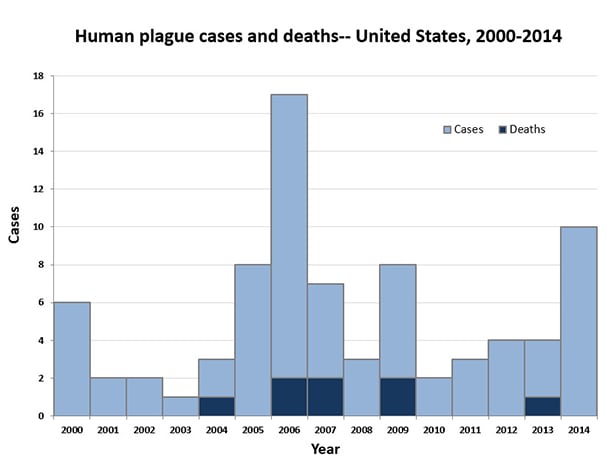 Credit: Wellcome images via Wikimedia commons
Credit: Wellcome images via Wikimedia commons
If you've been following the news this summer, you may have gotten the unfounded impression that the next big plague pandemic is upon us. The media has sensationalized several cases of this misunderstood disease, including two cases in Colorado a few months ago. Yosemite National Park had to close several campgrounds when officials determined that there was an outbreak affecting several animals (mostly squirrels) and fleas, which tested positive for the causative bacteria. And news is now breaking that the plague has reached Michigan.
OK. The first thing we need to do is take a deep breath.
Thus far this year, 14 cases of this disease, long associated with frightening ancient history, have been diagnosed in the U.S., with four of these proving fatal. But what's most important to note is that this ancient killing machine isn't making a comeback, rather its the normal happenings of a now-contained disease that never really left us.
First, a few definitions. The plague is an infectious disease caused by the bacteria Yersinia pestis. The disease manifests itself in different ways, depending on the where the infection is primarily localized in the body. If the infection is in the lymphatic system, it's referred to as the bubonic plague because of the swelling of the lymph nodes (or buboes). If the infection is localized in the blood, it is called septicemic plague. Finally, if it's in the lungs the applicable term is pneumonic plague. The bubonic plague is the most common form.
It is true that, historically, the plague was both unrelenting and devastating, most notably during the Middle Ages when it wiped out an estimated 50-100 million people worldwide. Most historians have identified three separate plague pandemics: one in the 6th century; the biggest in the 14th century (which the "black death" label is reserved for); and a modern-day plague, still considered active by the WHO as recently as the 1950s.
But keep in mind, the plague doesn't just strike with large pandemics; there are sporadic cases around the globe every year. The WHO reports that worldwide in 2013, there were almost 800 cases with 126 fatalities either confirmed or suspected. The CDC reported that between 1990 and 2012, the United States had over a 1,000 cases confirmed or suspected. Recent years have seen an average of seven cases per year, with an annual range of one to 17. Most cases are contracted in the U.S. occur in southwestern states of New Mexico, Colorado, Arizona, as well as in southern California.
 Source: CDC
Source: CDC
In light of these data, 14 U.S. cases for this year are consistent with historical trends. Further, the geographical location of these cases is consistent with theses data. (Actually the newest case from Michigan involves a woman who recently traveled to Colorado.)
Also, provided it's diagnosed early (and those buboes are very diagnostic), the plague is very treatable with common antibiotics. There's even a vaccine (although it is not very effective yet and it's reserved mostly for high-risk people, like those who do research on the causative agent).
The plague has a long history with humans, and it never left us. So while there's no need to bring back the "plague doctors" (one pictured above), or to have officials go town to town asking citizens to "bring out your dead," the plague's prevalence is nowhere near the epidemic levels of days of yore.